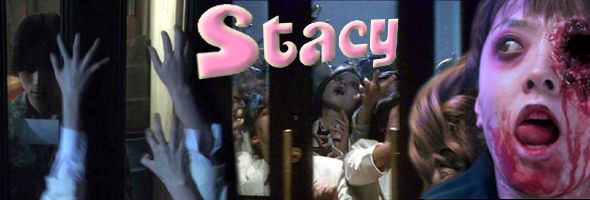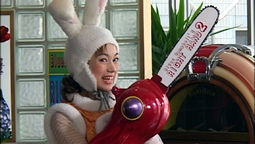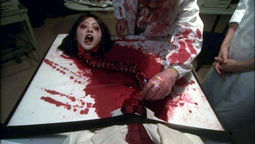
Colour, 2001, 79m. / Directed by Naoyuki Tomomatsu / Starring Natsuki Kato, Tomoko Hayashi / Synapse (US R1 NTSC) / WS (1.78:1) (16:9) / DD2.0
In the 21st century (err, now, that is), the world's population has been hit hard by a strange plague. All girls between the ages of 15 to 17 die after a brief state of N.D.H. ("near death happiness") and, covered in a sparkly substance called B.T.P. ("butterfly twinkle powder"), return as zombies called "Stacys." A decidedly unbalanced, Nobel Prize-winning scientist, Dr. Sukekiyo (Yasutaka Tsutsui), proclaims that the only way to kill a Stacy is via "repeat kill," i.e., hacking up the Stacy's body into 165 pieces. Meanwhile residents are instructed by a bunny-eared TV host to off their daughters with the newest hot consumer product, a light, portable, hand-held chainsaw called "Bruce Campbell's Right Hand 2" (though the label clearly says "Blues Campbell's Right Hand 2"... but never mind). Once a week the Stacy remains are deposited curbside for government pick-up by the Romero Repeat Kill Troop, who are also available to kill Stacys should a family member be unable to do the dirty work himself. However, three girls approaching Stacyhood decide to intercept emergency calls to Romero and start their own business, the Drew Illegal Repeat Kill Troop ("named after Drew Barrymore! We love her!").
Got all that? This skewed adaptation of a pulp novel by Kenji Otsuki gleefully tips its hat (perhaps excessively) to all the obligatory walking dead films, from Evil Dead to Day of the Dead, though the more obvious target is actually Japanese pop culture itself. As with Battle Royale, this film mocks the overly sentimental, mushy trend in teen entertainment, with heartfelt proclamations of love accompanied by syrupy music disrupted by the occasional swipe of a chainsaw. The bizarre, philosophical ending feels like an unholy collision of Nigel Kneale's Quatermass lore with Hello Kitty, something
Synapse's DVD is perhaps the finest-looking presentation of a Japanese DTV title; it's not quite as glossy as a film transfer but closer than one might expect. Colors are rich throughout, with only a deliberately cheap-looking TV interview displaying any shortcomings. The audio is also clear and sharp, doing justice to the bizarre retro-lounge/funk score. Optional yellow English subtitles are clear and easy to read throughout. Extras include the Japanese trailer and Patrick Macias' interesting liner notes, which pose a theory about the film's underlying statement about the fascination with giggly Japanese schoolgirls.
When Scream introduced the "postmodern" slasher film, few noted that Return of the Living Dead had already done the same trick with zombie films a decade earlier. Now the Japanese have come up with a "post-postmodern" spin on the same idea in the form of Stacy, a shot-on-video jawdropper filled with shambling Asian schoolgirls hungry for human flesh. Packed with countless, in-your-face references to Western undead films, this is a treat for horror die-hards but won't make a lick of sense to casual viewers.
 Of course, who cares what they think?
Of course, who cares what they think?
 And on top of that, the pretty and mysterious Eiko (Kato) approaches shy puppetmaker Nozomi (Hayashi) with a strange bargain: she'll sleep by his side, and he'll agree to off her when her time comes. All of these elements come together in a very gory climax at a government compound, where an unleashed horde of Stacys, the Romero and Drew squads, and the mad doctor all collide in a frenzy of torn limbs, bloodshed, and twinkle powder.
And on top of that, the pretty and mysterious Eiko (Kato) approaches shy puppetmaker Nozomi (Hayashi) with a strange bargain: she'll sleep by his side, and he'll agree to off her when her time comes. All of these elements come together in a very gory climax at a government compound, where an unleashed horde of Stacys, the Romero and Drew squads, and the mad doctor all collide in a frenzy of torn limbs, bloodshed, and twinkle powder.
 even stranger to witness than it sounds. On the downside, the puppeteer subplot really wears out its welcome fast; far too much time is spent on Eiko's NDH giggling, which could send viewers lunging for the mute button. Gorehounds will be pleased by the red stuff on display, with body parts and grue flying in every direction, though the budget means some of the effects look a bit less convincing than they probably should. All in all, it's not really "good" in the traditional sense (and several tiers below most of its companions in the Japanese zombie wave), but Stacy is just odd and bloody enough to make for solid party viewing.
even stranger to witness than it sounds. On the downside, the puppeteer subplot really wears out its welcome fast; far too much time is spent on Eiko's NDH giggling, which could send viewers lunging for the mute button. Gorehounds will be pleased by the red stuff on display, with body parts and grue flying in every direction, though the budget means some of the effects look a bit less convincing than they probably should. All in all, it's not really "good" in the traditional sense (and several tiers below most of its companions in the Japanese zombie wave), but Stacy is just odd and bloody enough to make for solid party viewing.
